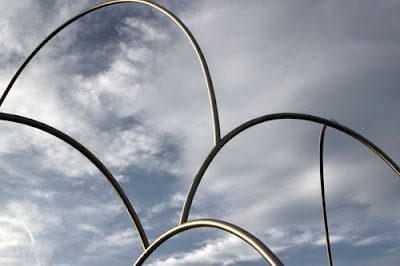Today it’s back to England, continuing my stories of creative connection. The day after my Hebden Bridge workshop I was able to gather with friends again for a visit to the Yorkshire Sculpture Park. I had seen pictures of this place before, and it looked intriguing. How often do you see sculptures just randomly popping out of the bushes? Not very often. It’s a photographer’s dream, this kind of interesting juxtaposition.
On a rainy Sunday morning four of us met up in Hebden Bridge to drive out to the park: Me, Fiona, Hannah, and this time adding the lovely Helen Agarwal into the mix. Helen is another artist I met at the Do What You Love Retreat in 2011. She is a wonderful photographer with a lovely point of view on the world. I enjoy her dreamy style and her calm approach to life.
We were lucky enough to have a break in the weather as we arrived, so we wandered outside for a while. It was fun to see what caught our eye. There were all of these interesting sculptures, but I think we spent more time photographing the beautiful vines and interesting leaves.
Helen is another mobile photographer. Her dSLR had been broken for a while, so she was trying to figure out what to do about repairing or replacing it, using her camera phone in its place. It was fun to see how she worked with it! Another influence for me? Perhaps. Just seeing other photographers whose work I enjoy using different tools than my own is often enough to get me thinking.
The special exhibit at the park was Joan Miro. I haven’t always been a fan of his work, but seeing so much more of his paintings and sculptures, and reading about his life gave me a new perspective on him. I do love the bold colors and simple shapes he repeats in his work. We couldn’t take photographs of the inside exhibition, but I was able to photograph his outdoor sculptures. I always find it interesting to see an artist who works across many mediums, like painting and sculpture, because you can see their style come through regardless of medium.
He talked about how he works in this quote, posted on the wall:
I think of my studio as a vegetable garden. Here, there are artichokes. Over there, potatoes. The leaves have to be cut so the vegetables can grow. At a certain moment, you must prune. I work like a gardener or a wine grower. Everything takes time. My vocabulary of forms, for example, did not come to me all at once. It formulated itself almost in spite of me. Things follow their natural course. They grow, they ripen. You have to graft. You have to water, as you do for lettuce. Things ripen in my mind. In addition, I always work on a great many things at once. And even in different areas: painting, etching, lithography, sculpture, ceramics.
Yes, things have to grow and ripen. Our ideas. Our art. Our connections and friendships as well. Perhaps my visit to England was a gardening trip, nurturing the connections I had planted while living in Italy. Coaxing them to grow a little further, to see how they might blossom in time.























